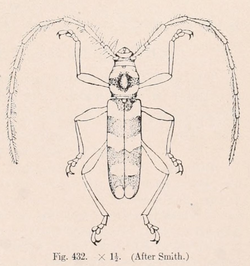Biology:Dryobius sexnotatus
| Dryobius sexnotatus | |
|---|---|

| |
| D. sexnotatus. | |
| Scientific classification | |
| Kingdom: | |
| Phylum: | |
| Class: | |
| Order: | |
| Suborder: | |
| Family: | |
| Subfamily: | |
| Tribe: | |
| Genus: | Dryobius LeConte, 1850
|
| Species: | D. sexnotatus
|
| Binomial name | |
| Dryobius sexnotatus Linsley, 1957
| |
| Synonyms[4] | |
Dryobius sexnotatus is a species of beetle in the family Cerambycidae. It is the only species in the monospecific genus Dryobius.
Taxonomic history
The species was initially described by Thomas Say, who named it Callidium 6-fasciatum. He placed it in the genus Callidium.[1] In 1850, John Lawrence LeConte transferred the species to be the sole member of his newly-circumscribed genus Dryobius, making the name D. 6-fasciatus.[2] LeConte emended the specific name from 6-fasciatus to sexfasciatus in 1859.[3]
In 1957, Earle Gorton Linsley coined the nomen novum Dryobius sexnotatus for this species as there was already a senior homonym with the same specific name used by a beetle described by Guillaume-Antoine Olivier prior to Say's description.[5]
The etymology of the generic name comes from the Greek words δρῦς tree and βιόω to live.[6]
Distribution
Most specimens of D. sexnotatus come from the Ohio River Valley, but it has been documented in at least fourteen states in the eastern United States.[7]
Biology
Its larvae eat maple, beech, basswood, and elm trees.[7]
Its flight period ranges from early March through early September, but is most common from mid-June through mud-July.[7]
The pheromones produced by males include 1-(1H–pyrrol-2-yl)-1,2-propanedione and (R)-3-hydroxyhexan-2-one.[8]
References
- ↑ 1.0 1.1 Say, Thomas (1824). "Descriptions of Coleopterous Insects collected in the late Expedition to the Rocky Mountains performed by the order of Mr. Calhoun, Secretary of War, under the command of Major Long (Continued)". Journal of the Academy of Natural Sciences of Philadelphia 3 (2): 415–416. https://www.biodiversitylibrary.org/page/24669071.
- ↑ 2.0 2.1 LeConte, John L. (1850). "An attempt to classify the Longicorn Coleoptera of the part of America North of Mexico (continued)". Journal of the Academy of Natural Sciences of Philadelphia. Second series 2 (1): 23. https://www.biodiversitylibrary.org/page/35730940.
- ↑ 3.0 3.1 LeConte, John L. (1859). "The Coleoptera of Kansas and Eastern New Mexico". Smithsonian Contributions to Knowledge 11 (6): 20. https://www.biodiversitylibrary.org/page/9041955.
- ↑ Barsevskis, Arvids, ed. "Dryobius sexnotatus Linsley, 1957". http://cerambycidae.org/taxa/sexnotatus-Linsley-1957.
- ↑ Linsley, E. Gorton (1957). "Some New Genera and Species of North American Cerambycidae (Coleoptera)". The Canadian Entomologist 89 (6): 287. doi:10.4039/Ent89283-6.
- ↑ Blatchley, W. S. (1910). An Illustrated Descriptive Catalogue of the Coleoptera or Beetles (Exclusive of the Rhynchophora) Known to Occur in Indiana. Indianapolis: Nature Publishing. p. 1021. https://www.biodiversitylibrary.org/page/1881052.
- ↑ 7.0 7.1 7.2 Perry, Robert H.; Surdick, Robert W.; Anderson, Donald M. (1974). "Observations on the Biology, Ecology, Behavior, and Larvae of Dryobius sexnotatus Linsley (Coleoptera: Cerambycidae)". The Coleopterists Bulletin 28 (4): 169–176.
- ↑ Diesel, Natalie M.; Zou, Yunfan; Johnson, Todd D.; Diesel, Donald A.; Millar, Jocelyn G.; Mongold-Diers, Judith A.; Hanks, Lawrence M. (2017). "The Rare North American Cerambycid Beetle Dryobius sexnotatus Shares a Novel Pyrrole Pheromone Component with Species in Asia and South America". Journal of Chemical Ecology 43 (8): 739–744. doi:10.1007/s10886-017-0875-3. ISSN 0098-0331.
Wikidata ☰ Q14834257 entry

